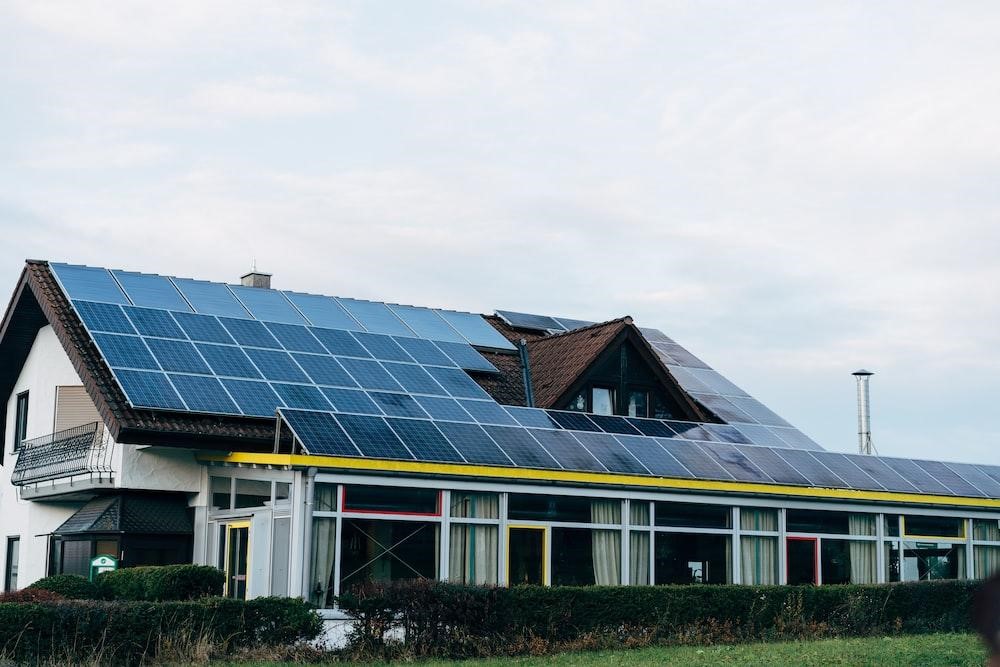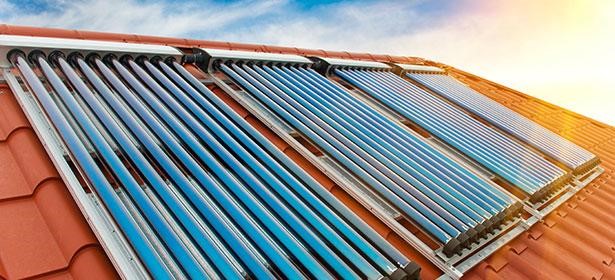Solar technology is slowly becoming widespread. However, it’s still relatively new for many people who may not completely understand the technology.
For instance, “solar panels” is a general term that covers solar photovoltaic panels and solar thermal panels.
But converting solar power into energy is where their similarities end. In this article, we’ll talk about the difference between solar photovoltaic panels vs solar thermal panels.
Overview of Photovoltaic Panels and Solar Panels
Both panels absorb the sun’s energy to generate power for your home. They both typically rely on roof space as well.
Outside of that, the two systems are very different.
Solar PV systems turn sunlight into electrical energy. The way PV systems work is that two layers of a semi-conducting metal (usually silicon) produce an electric field.
It generates a small voltage when it’s hit by sunlight.
Meanwhile, solar thermal panels (also known as solar collectors) turn sunlight into heat.
The panel has tubes filled with glycol with antifreeze (or other liquid). When the sun’s heat reaches the liquid, it also heats a copper coil. This will then warm your hot water tank.
Comparing Photovoltaic and Solar Panels
When talking about domestic solar panels, a household’s main concern is a system’s efficiency.
After all, you’ll want a solar system with enough energy output for your needs.
Efficiency of Photovoltaic Panels

Solar PV panels have only 15 to 20% efficiency. Because of that, you’ll need more of this type of panel to absorb and convert solar energy.
These panels consist of solar cells with two layers of semi-conducting material and silicon. When a photovoltaic cell is hit by sunlight, they create an electric field through the photovoltaic effect.
The resulting direct current flows to an inverter to be converted to alternating current — which is what home appliances use.
There are three main types of solar PV panels:
- Monocrystalline
- Polycrystalline
- Thin film solar cells
The panels differ in terms of price, efficiency rate, and flexibility.
Efficiency of Solar Panels

Solar thermal panels have an impressive 70% efficiency rate. That means you’ll need less space and fewer thermal panels.
A solar thermal collector has tubes filled with glycol and antifreeze. These tubes are aligned next to one another.
When the liquid is hot, it’s transported to a copper coil that warms the hot water tank or cylinder.
Slow- and medium-temperature collectors have either flat plate panels or tubes. Meanwhile, high-temperature collectors can be concentrated systems called solar towers and Fresnel reflectors, among others.
A heat pump moves the liquid through the system to prevent it from cooling the water in the tank on cold days.
Advantages and Disadvantages of Photovoltaic and Solar Panels
If you’re considering solar PV panels vs solar thermal panels, then you’ll need to know the pros and cons of each one.
A. Advantages of Photovoltaic Panels
Let’s first talk about the benefits of having solar PV panels:
1. Longer Life Span
Solar PV panels can last up to 50 years. While they work best during summer, they also don’t freeze over the winter.
2. Multi-Purpose
Solar photovoltaic systems may be less efficient than solar thermal systems, but these are more multi-purpose.
That’s because they’re made for electricity generation — meaning you can use them for all your appliances.
Thanks to that, you can cut your electricity bills by a lot.
3. Lower Maintenance Costs
Solar PV panels need little to no maintenance compared to thermal panels. This is because they don’t have any moving parts.
B. Advantages of Solar Panels
In contrast, let’s talk about how you can benefit from solar thermal collectors:
1. Cost-Effective
Solar thermal technology is relatively cheap to install. It also has a shorter payback time compared to solar PV panels.
You’ll also lower your energy bills since you get hot water from a renewable energy source.
2. Easy Installation
This kind of solar panel is space-efficient. In fact, it only needs around 3×4 m².
That’s because solar thermal collectors are more efficient — converting 70 to 90% of solar radiation for your hot water tank.
3. Can Be Integrated Into Existing Systems
You can combine solar PV systems and solar thermal systems with the same panels.
Integrating the two systems means you can produce electricity and hot water with a lower carbon footprint.
You can also combine a solar thermal system with central gas heating to ensure you’re covered for the cold months.
C. Disadvantages of Photovoltaic Panels
While solar PV panels can lower electricity costs by a lot, they have some drawbacks you should consider too:
1. High Initial Cost
PV panels are expensive upfront. Aside from that, they’re a long-term investment.
Yes, you’ll produce your own electrical energy, lowering your bills the moment you install them. However, the return on investment can last seven to 20 years.
On top of that, installing solar PV panels requires a lot of space, regardless of the solar PV panel size.
2. Low Efficiency
Solar PV panels have an efficiency of only 15 to 20%.
This is why you need a lot of roof space to install more panels properly.
3. Difficult Installation
Solar panels are more complex than difficult. After all, you’re dealing with electrical wiring and other components.
If you don’t like being on the roof or working with electricity, then it’s best to leave it to professionals.
However, there are now DIY installation kits and solar PV installation courses for those who want to try it.
The difficulty in installing solar panels means they’re also very expensive to move. Because of that, it’s best for those living on long-term property.
D. Disadvantages of Solar Panels
If you’re considering utilising solar thermal energy, below are some cons to know:
1. Single-Purpose
A solar thermal panel is good only for water heating purposes.
Because it’s single-purpose, it has limited storage too. Storing hot water for a long time is very hard without a large heat loss.
If you have too much in the water tank, you’ll have to manually let the hot water out.
2. Short Life Span
Solar thermal collectors have moving parts, so they have a lifespan of only 20 years.
Aside from the moving parts, glycol liquid in the panels themselves can result in maintenance costs of £200 or more a year.
3. Less Durable
Solar thermal panels are more affected by cold weather. They aren’t as effective since there’s not enough solar thermal energy to work with.
Frequently Asked Questions
Now that you know the difference between solar PV and solar thermal panels, let’s look at some FAQs that can help you understand them more:
What If There Is Snow on Solar Panels?
Too much snow on the solar panels means they won’t be able to transform solar power into electricity or thermal energy.
Fortunately, snow isn’t heavy enough to cause structural issues.
If your panels have snow, you can clean them with lukewarm water or push the snow off.
Do Solar Panels Work in the Middle of a Blackout?
If you still rely on power plants, your solar system will shut down.
This lowers the risk of emergency responders and electricity utility repair people being injured when your panels send surplus energy back to the grid.
Can Solar PV Panels Heat Water?
Yes, a solar PV panel can heat water too.
That’s because a photovoltaic system can power anything that needs an electric current to function.
So, if you have electric heating equipment (including furnaces, hot water tanks, and gas or oil boilers), you can certainly use solar PV technology for water heating.
Are There Grants for Solar Panels?
Yes, you can get grants to fund your solar panel system. Some of these grants include:
Feed-In Tariff (FIT)
This government scheme allowed solar PV system owners to receive payments for every unit of electricity generated. These payments are made for up to 20 years.
Homeowners could even sell back excess solar energy to the grid.
This grant allows you to easily recoup the money you invested in the system.
Smart Export Guarantee (SEG)
The SEG lets homeowners sell excess electricity back to the grid. Licenced energy suppliers are obligated to buy a certain percentage of energy.
Renewable Heat Incentive (RHI)
This scheme pays quarterly cash payments for up to seven years for homeowners who transitioned to renewable energy technologies — including thermal and solar PV systems.
However, a professional renewable heating engineer must first issue an Energy Performance Certificate (EPC) before homeowners can apply for RHI.
Will I Still Get Electric Bills Even If I Have a Solar Panel System?
You’ll still receive electric bills if you’re connected to the grid. However, you can cut the amount you owe to £0.
But you won’t get electric bills if you have battery storage and live completely off the grid.
When installing solar panels, you’re still connected to the grid. This is so you can get power from the grid if your system isn’t producing enough for your needs.
You’ll also get to send power back to the grid if you’re making more than you need.
You can certainly go completely off the grid — but this is more expensive and unnecessary for most homeowners.
Is It Better to Buy or Lease a Solar Panel System?
It depends on your priorities.
If you want to maximise financial returns, buying your own system is better. But if you don’t want to deal with maintenance, you should lease a system.
Rest assured that both options can greatly reduce your energy bills and carbon footprint.
If you’re choosing to buy your own system with the help of a loan, you should further consider secured vs unsecured loans.
Secured loans have lower interest rates — however, you’ll need to set up an asset as collateral. If you don’t repay the loan, you’ll lose that asset.
Meanwhile, unsecured loans don’t require an asset. But that means they have higher interest rates.
Conclusion
Solar systems capture solar rays to create energy. Because the sun is a renewable energy source, it’s much greener than fossil fuels.
Solar thermal collectors transform solar energy into heat. Meanwhile, photovoltaic cells are great for generating electricity.
However, you can also use a photovoltaic system to heat water — as long as you have an electric heating system.

